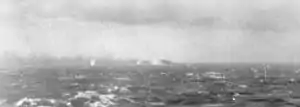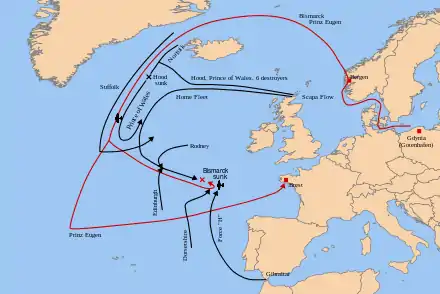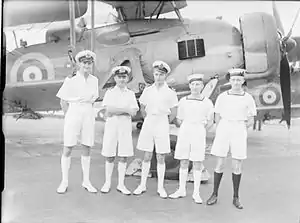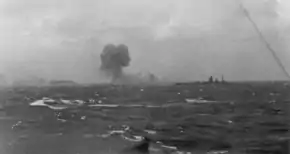Last battle of the battleship Bismarck
The last battle of the German battleship Bismarck took place in the Atlantic Ocean approximately 300 nmi (350 mi; 560 km) west of Brest, France, on 26–27 May 1941. Although it was a decisive action between capital ships, it has no generally accepted name.
| The last battle of the battleship Bismarck | |||||||
|---|---|---|---|---|---|---|---|
| Part of the Battle of the Atlantic | |||||||
 Surrounded by shell splashes, Bismarck burns on the horizon | |||||||
| |||||||
| Belligerents | |||||||
|
|
| ||||||
| Commanders and leaders | |||||||
|
|
| ||||||
| Strength | |||||||
|
1 aircraft carrier 2 battleships 2 heavy cruisers 1 light cruiser 7 destroyers | 1 battleship | ||||||
| Casualties and losses | |||||||
|
5 killed and wounded 1 light cruiser damaged[1] |
2,200 killed 111 captured 1 battleship scuttled[2] | ||||||
On 24 May, before the final action, Bismarck's fuel tanks were damaged and several machinery compartments, including a boiler room, were flooded in the Battle of the Denmark Strait. Her captain's intention was to reach the port of Brest for repair.[3] Late in the day Bismarck briefly turned on her pursuers (Prince of Wales and the heavy cruisers Norfolk and Suffolk) to cover the escape of her companion, the heavy cruiser Prinz Eugen to continue further into the Atlantic. Early on 25 May the British forces lost contact with Bismarck, which headed ESE towards France while the British searched NE, presuming she was returning to Norway. Later on 25 May Admiral Lütjens, apparently unaware that he had lost his pursuers, broke radio silence to send a coded message to Germany. This allowed the British to triangulate the approximate position of Bismarck and aircraft were dispatched to hunt for the German battleship. She was rediscovered in the late morning of 26 May by a Catalina flying boat from No. 209 Squadron RAF and subsequently shadowed by aircraft from Force H steaming north from Gibraltar.
The final action consisted of four main phases. The first phase late on the 26th consisted of air strikes by torpedo bombers from the British aircraft carrier Ark Royal, which disabled Bismarck's steering gear, jammed her rudders in a turning position and prevented her escape. The second phase was the shadowing and harassment of Bismarck during the night of 26/27 May by British destroyers, with no serious damage to any ship. The third phase on the morning of 27 May was an attack by the British battleships King George V and Rodney supported by cruisers. After about 100 minutes of fighting, Bismarck was sunk by the combined effects of shellfire, torpedo hits and deliberate scuttling.[4] On the British side, Rodney was lightly damaged by near-misses and by the blast effects of her own guns.[5] British warships rescued 111 survivors from Bismarck[6] before being obliged to withdraw because of an apparent U-boat sighting, leaving several hundred men to their fate. The following morning, a U-boat and a German weathership rescued five more survivors. In the final phase the withdrawing British ships were attacked the next day on 28 May by aircraft of the Luftwaffe, resulting in the loss of the destroyer HMS Mashona.
Background

Bismarck's second sea battle was made unavoidable by the decisions of the Fleet Commander (Günther Lütjens), taken well before the encounter with Hood and Prince of Wales.
Even before the breakout into the North Atlantic, Lütjens had decided against conducting an underway refuelling in the Greenland Sea with Weissenburg,[7] one of the pre-positioned German tankers, before his ships entered the Denmark Strait. And when, as a result of the battle with Hood and Prince of Wales, Bismarck lost access to several thousand tons of fuel in her forecastle due to a shell hit from Prince of Wales (aft of the forecastle, in her anchor locker), Lütjens had to order his ships to slow down to conserve fuel. The decrease in speed made Force H’s airborne torpedo attacks inevitable, and those attacks led directly to the final encounter with the Home Fleet.
Determined to avenge the sinking of the "Pride of the Navy" HMS Hood in the Battle of the Denmark Strait, the British committed every possible unit to hunting down Bismarck. The old Revenge-class battleship HMS Ramillies was detached from convoy duty southeast of Greenland and ordered to set a course to intercept Bismarck if she should attempt to raid the sea lanes off North America.
Prince of Wales and the cruisers Norfolk and Suffolk were still at sea in the area and tailing the German ships. A British force, the battleship King George V, the carrier Victorious and their escorts, had set sail from Scapa Flow before the loss of the Hood. The battleship Rodney was detached from escort duties on 24 May.

During the early evening of 24 May, an attack was made by a small group of Swordfish biplane torpedo bombers of 825 Naval Air Squadron under the command of Eugene Esmonde from the aircraft carrier HMS Victorious. One hit was scored, but caused only superficial damage to Bismarck's armoured belt.
For some time, Bismarck remained under long-distance observation by the British. At about 03:00 on 25 May, she took advantage of her opponents' zig-zagging to double back on her own wake; Bismarck made a nearly 270° turn to starboard, and as a result her pursuers lost sight of the battleship, thus enabling her to head for German naval bases in France unnoticed. Contact was lost for four hours, but the Germans did not know this. For reasons that are still unclear, Admiral Günther Lütjens transmitted a 30-minute radio message to HQ, which was intercepted, thereby giving the British time to work out roughly where he was heading. However, a plotting error made onboard King George V, now in pursuit of the Germans, incorrectly calculated Bismarck's position and caused the chase to veer too far to the north. Bismarck was therefore able to make good time on 25/26 May in her unhindered passage towards France and protective air cover and destroyer escort. By now, however, fuel was becoming a major concern to both sides.
The British had a stroke of luck on 26 May. In mid-morning a Coastal Command Catalina reconnaissance aircraft from 209 Squadron RAF had flown over the Atlantic from its base on Lough Erne in Northern Ireland across the Donegal Corridor.[8] It was piloted by British Flying Officer Dennis Briggs[9] and co-piloted by US Navy observer Ensign Leonard B. Smith, USNR.[10] Smith was at the controls when he spotted Bismarck (via a trailing oil slick from the ship's damaged fuel tank) and reported her position to the Admiralty. From then on, the German ship's position was known to the British, although the enemy would have to be slowed significantly if heavy units hoped to engage outside the range of German land-based aircraft. All British hopes were now pinned on Force H, whose main units were the aircraft carrier HMS Ark Royal, the battlecruiser HMS Renown and the light cruiser HMS Sheffield. This battle group, commanded by Admiral James Somerville, had been diverted north from Gibraltar.
The battle
Night of 26/27 May
At dusk that evening, and in atrocious weather conditions, Swordfish from Ark Royal launched an attack. The first wave mistakenly targeted Sheffield which had been detached from Force H under orders to close and shadow Bismarck. Although precious time was lost by this incident, it proved beneficial to the British in that the magnetic detonators on the torpedoes used against Sheffield were seen to be defective and for the following attack on Bismarck were replaced by those designed to explode on contact. Despite the lateness of the day, it was decided to try again. The attack commenced in near darkness at around 21:00 but once again the Swordfish torpedo bombers found Bismarck with their ASV II radars.[11] A hit by a single torpedo from a Swordfish, hitting her port side, jammed Bismarck's rudder and steering gear 12° to port.[12] This resulted in her being, initially, able to steam only in a large circle. Repair efforts by the crew to free the rudder failed.[13] Bismarck attempted to steer by alternating the power of her three propeller shafts, which, in the prevailing force 8 wind and sea state, resulted in the ship being forced to sail towards King George V and Rodney, two British battleships that had been pursuing Bismarck from the west.[14] At 23:40 on 26 May, Admiral Lütjens delivered to Group West, the German command base, the signal "Ship unmanoeuvrable. We will fight to the last shell. Long live the Führer."[15]
Throughout that night, Bismarck was the target of intermittent torpedo attacks by the destroyers HMS Cossack, Sikh, Maori and Zulu, and the Polish destroyer ORP Piorun. One of Bismarck's shells sheared off Cossack's antenna and three other shells straddled Zulu wounding three men. The British destroyers didn’t score any hits, but the constant worrying tactics of the British helped wear down the morale of the Germans and deepened the fatigue of an already exhausted crew.
The final action

As the British units converged on Bismarck's location, Tovey instructed the commander of Rodney to close to within 15,000 yd (14,000 m) as quickly as possible, and that while he should in general conform to King George V's movements, he was free to manoeuvre independently.[16] The morning of Tuesday 27 May 1941 brought a heavy grey sky, a rising sea and a tearing wind from the northwest. Because of this northwesterly gale, Tovey concluded an attack on Bismarck from windward was undesirable. He decided to approach on a northwesterly bearing before deploying.[17] For her part, Bismarck was still unmanoeuvrable; her crew made what preparations they could for the inevitable engagement, including pushing her Arado floatplane overboard to reduce the risk of fire.[18]
At 08:43, lookouts on King George V spotted Bismarck, some 25,000 yd (23,000 m) away; Rodney opened fire first at 08:47, followed quickly by King George V. Bismarck returned fire at 08:50 with her forward guns; with her second salvo, she straddled Rodney; this was the closest she came to scoring a hit on any British warship in the engagement.[19] At 09:02, a 16-inch (406 mm) salvo from Rodney struck the forward superstructure, damaging the bridge and main fire control director and killing most of the senior officers. The salvo also damaged the forward main battery turrets. The aft fire control station took over direction of the aft turrets, but after three salvos was also knocked out. With the main fire control position out of action, Bismarck's shooting became increasingly erratic, allowing the British to close the range. Norfolk and Dorsetshire closed and began firing with their 8 in (203 mm) guns.[20][21]
By 09:31, all four of Bismarck's main battery turrets were out of action, allowing Rodney to close to around 3,000 yd (2,700 m) with impunity to fire her guns at what was point-blank range into Bismarck's superstructure. King George V remained at a greater distance to increase the possibility that her shells would strike Bismarck's decks. During this period, Rodney launched a pair of torpedoes at Bismarck, claiming one hit. The two battleships quickly reduced their German opponent to a shambles, aflame from stem to stern, though the Germans refused to surrender. The ship was settling by the stern due to uncontrolled flooding and had taken on a 20 degree list to port by 10:00. By that time, the two British battleships had fired some 700 large-caliber shells at Bismarck,[22] all told, the two battleships, Dorsetshire, and Norfolk fired some 2,800 shells, scoring around 400 hits.[23]
At around this time, First Officer Hans Oels, the senior surviving officer, issued the order to abandon ship. He also instructed the engine-room crews to open the ship's watertight doors and prepare scuttling charges.[24] Gerhard Junack, the chief engineering officer, ordered his men to set the demolition charges with a 9-minute fuse but the intercom system broke down and he sent a messenger to confirm the order to scuttle the ship. The messenger never returned and Junack primed the charges and ordered the crew to abandon the ship.[4]
Meanwhile, Tovey's battleships were running low on ammunition and fuel; at 10:20, he ordered Dorsetshire to close and torpedo the crippled Bismarck while King George V and Rodney turned for port.[23] Dorsetshire fired a pair of torpedoes into Bismarck's starboard side, one of which hit. Dorsetshire then moved around to her port side and fired another torpedo, which also hit. By the time these torpedo attacks took place, the ship was already listing so badly that the deck was partly awash. Based on subsequent examination of the wreck, the last torpedo appears to have detonated against Bismarck's port side superstructure, which was by then already underwater.[25][26] The ship began capsizing at about 10:35, and by 10:40 had slipped beneath the waves, stern first.[27]
Survivors
_image_03_Bismarck.JPG.webp)
Dorsetshire and Maori attempted to rescue survivors, but a U-boat alarm caused them to leave the scene after having rescued only 111 Bismarck sailors, leaving the majority of Bismarck's survivors from the 2,200-man crew (around 800) to the rough Atlantic waters. The next morning, U-74, dispatched to try to rescue Bismarck’s logbook (and which heard sinking noises from a distance), picked up three survivors in a raft (Herzog, Höntzsch, and Manthey) and the German weather ship Sachsenwald picked up two survivors in another raft (Lorenzen and Maus) before finding another raft that was empty.
Aftermath
After the sinking, Admiral John Tovey said, "The Bismarck had put up a most gallant fight against impossible odds worthy of the old days of the Imperial German Navy, and she went down with her colours flying."
The Board of the Admiralty issued a message of thanks to those involved:
Their Lordships congratulate C.-in-C., Home Fleet, and all concerned in the unrelenting pursuit and successful destruction of the enemy's most powerful warship. The loss of H.M.S. Hood and her company, which is so deeply regretted, has thus been avenged and the Atlantic made more secure for our trade and that of our allies. From the information at present available to Their Lordships there can be no doubt that had it not been for the gallantry, skill, and devotion to duty of the Fleet Air Arm in both Victorious and Ark Royal, our object might not have been achieved.[28]
Unaware of the fate of the ship, Group West, the German command base, continued to issue signals to Bismarck for some hours, until Reuters reported news from Britain that the ship had been sunk. In Britain, the House of Commons was informed of the sinking early that afternoon.[29]
After the battle, the British warships returned to the United Kingdom with 111 Bismarck survivors. One died later of his wounds. After a period of interrogation and processing, the survivors spent the rest of the war as prisoners. No British ship was sunk during this action, but the destroyer HMS Mashona was sunk by the Luftwaffe during the withdrawal the following day.
Several Bismarck survivors spoke afterwards of a sailor on Dorsetshire, Midshipman Joe Brooks, who leapt into the water in an unsuccessful attempt to rescue a German sailor who had lost both his arms. In a 1989 National Geographic documentary on Bismarck, one of the survivors said, "the name Joe Brooks meant something to us; our government should've given that man a medal for humaneness."
Order of battle
Axis
- German battleship Bismarck
Allied
- The British battleships King George V and Rodney.
- The British aircraft carrier Ark Royal
- The British heavy cruisers Norfolk and Dorsetshire.
- The British light cruiser Sheffield.
- The British destroyers Cossack, Sikh, Zulu, Maori, Mashona, Tartar
- The Polish destroyer ORP Piorun
Neutral
- Spanish heavy cruiser Canarias (attempted to rescue some survivors from Bismarck)
See also
- Operation Rheinübung, the intended mission of Bismarck and Prinz Eugen
- Sink the Bismarck!, a 1960 film based on C. S. Forester's book The Last Nine Days of the Bismarck
- "Sink the Bismarck", a 1960 song by Johnny Horton inspired by the film of the same name.
- Computer Bismarck, a 1980 computer game that simulates the battle.
- Unsinkable Sam, a ship's cat on board Bismarck who survived the sinking and was adopted by the Royal Navy.
Notes
- Grove, Battle Summary 5, paragraph 26: Bismarck fired 6 38 cm salvos at HMS Sheffield and 38 cm splinters caused 5 casualties.
- Bismarck’s complement as Fleet Flagship was 2220 (2092 + 128 Fleet staff) (Chesnau, p.224). For Operation Rheinubung she embarked over 100 supernumeraries, including merchant seamen to act as prize crews, cadets in training, and a film unit (Kennedy, p.33). The number of these supernumeraries, and hence the exact number of casualties, is unknown.
- Cameron, pp. 6–10.
- Gaack & Carr, pp. 80–81
- Kennedy, pp. 206, 283.
- One of these survivors died of his injuries, while the remainder became prisoners of war.
- Zetterling & Tamelander, pp. 121–122
- BBC – WW2 People's War – World War Memories of an Ulster Childhood
- ""We Shadowed the Bismarck" – In Flg Off. Dennis Briggs' Words | Britain at War". Retrieved 30 January 2019.
- 4 November 2009, Bismarck: British/American Cooperation and the Destruction of the German Battleship, Naval History and Heritage Command
- Brown, p.34
- "Bismarck's· Final· Battle· -· Part· 2". navweaps.com. Archived from the original on 17 July 2016. Retrieved 26 July 2016.
- Garzke & Dulin, p. 235
- Garzke & Dulin, pp. 235–236
- Jackson 2002, p. 91.
- Garzke & Dulin 1980, p. 210
- Barnett, p. 311
- Garzke & Dulin 1985, pp. 237–238
- Bercuson & Herwig, pp. 288–289
- Bercuson & Herwig, pp. 290–291
- Garzke & Dulin 1985, p. 239
- Bercuson & Herwig, pp. 291–294
- McGowen, p. 56
- Bercuson & Herwig, pp. 292–294
- Jurens et. al.
- Zetterling & Tamelander, p. 281
- Garzke & Dulin 1985, p. 246
- "Congratulations to the Fleet". The Times (48938). 29 May 1941. p. 4. Retrieved 19 October 2010.
- "WAR SITUATION".
References
- Bercuson, David J. and Holger H. Herwig. The Destruction of the Bismarck. Woodstock and New York: The Overlook Press, 2001. ISBN 1-58567-192-4.
- Brown, J. D. (1968). Carrier Operations in World War II. Shepperton, UK: Ian Allan. ISBN 978-0-7110-0040-7.
- Cameron J., Dulin R., Garzke W., Jurens W., Smith K.,The Wreck of DKM Bismarck A Marine Forensics Analysis
- Carr, Ward (August 2006). "SURVIVING the Bismarck's Sinking". Naval History. 20. ISSN 1042-1920.
- Chesnau, Roger (Ed.) Conway's All the World's Fighting Ships, 1922–1946. Conway Maritime Press, 1980. ISBN 0-85177-146-7
- Dewar, A.D. Admiralty report BR 1736: The Chase and Sinking of the “Bismarck”. Naval Staff History (Second World War) Battle Summary No. 5, March 1950. Reproduced in facsimile in Grove, Eric (ed.), German Capital Ships and Raiders in World War II. Volume I: From “Graf Spee” to “Bismarck”, 1939–1941. Frank Cass Publishers 2002. ISBN 0-7146-5208-3
- Gaack, Malte; Carr, Ward (2011). Schlachtschiff Bismarck—Das wahre Gesicht eines Schiffes—Teil 3 (in German). Norderstedt, Germany: BoD – Books on Demand GmbH. ISBN 978-3-8448-0179-8.
- Garzke, William; Dulin, John (1990). Battleships: Axis and Neutral Battleships in World War II. Annapolis: Naval Institute Press. ISBN 978-0-87021-101-0.
- Garzke, William; Dulin, John; Jurens, William (2019). Battleship Bismarck: A Design and Operational History. Annapolis: Naval Institute Press. ISBN 978-1-59114-569-1.
- Garzke, William; Dulin, John (1994). "The Bismarck's Final Battle". Warship International. XXXI (2): 158–190. ISSN 0043-0374.
- Jackson, Robert (2002). The Bismarck. London: Weapons of War. ISBN 978-1-86227-173-9.
- Kennedy, Ludovic. Pursuit: The sinking of the Bismarck. William Collins Sons & Co Ltd 1974. ISBN 0-00-211739-8
- Jerzy Pertek, Wielkie dni małej floty (Great Days of a Small Fleet), Zysk i S-ka, 2011, ISBN 978-83-7785-707-6
- Michael A. Peszke, Poland's Navy 1918-1945, Hippocrene Books, 1999, ISBN 07818-0672-0
- Müllenheim-Rechberg, Burkard von. Battleship Bismarck: A Survivor’s Story. Triad/Granada, 1982. ISBN 0-583-13560-9.
- Schofield, B.B. Loss of the Bismarck. Ian Allan, 1972. ISBN 0-7110-0265-7
- Tovey, Sir John C. SINKING OF THE GERMAN BATTLESHIP BISMARCK ON 27™ MAY, 1941.
- Zetterling, Niklas; Tamelander, Michael (2009). Bismarck: The Final Days of Germany's Greatest Battleship. Drexel Hill: Casemate.